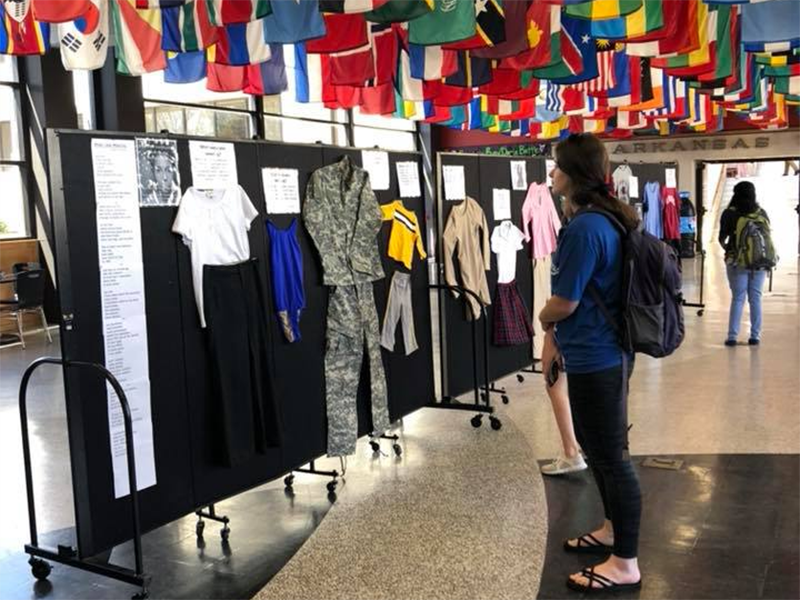
Sexual Assault Awareness Month continues on the U of A campus this week with the 10th anniversary of the What Were You Wearing Exhibit, or WWYW.
The original exhibit, which was created at the U of A 10 years ago, will be displayed in the Arkansas Union International Connections Lounge from today through Thursday, April 22-25, and will be on display all day, each day.
"Come see the exhibit that silently dispels age old, victim-blaming myths about sexual assault," said Mary Wyandt-Hiebert, director of the university's Sexual & Relationship Violence Center. "This year is special because it marks the 10th anniversary of WWYW, and we started it right here on the U of A campus."
Wyandt-Hiebert was at a training in 2013 with Jen Brockman, who was a sexual assault prevention educator at the U of A, when they had the idea for the exhibit.
"We had a conversation over lunch about a poem that was included within the training packet. I honestly cannot tell you what the training was about, but I can say that the poem spoke loudly to both of us," Wyandt-Hiebert said. "As we read the poem, 'What I was Wearing,' by Mary Simmerling, both of us reflected on the countless times we have worked with victims/survivors and how clothing so often came up as others would often ask, 'what were you wearing.' Our conversation centered around how can we do something about this."
After coming up with several ideas on how to create this awareness, they decide to keep the focus on the clothing.
"So, we set forth with asking victims/survivors we have been working with if they would be willing to contribute by sharing their outfit. We gathered clothing that matched the outfit descriptions and went about putting the exhibit together. The first display was held April 2014 as part of Sexual Assault Awareness Month."
"I've always had a visceral response to seeing the exhibit in the union," said Meredith Brady, office manager for Sexual & Relationship Violence Center. "You know what happened, you know the stories, but you're confronted by the fact that these are mostly just normal, everyday clothes like the ones in your own closet. It really drives home the point that it's not about what you're wearing or even what you're doing, it's entirely about the choices made by the person who has attacked you in this way. It's an important distinction to make."
The exhibit universally addresses sexual violence in a simple and understandable way.
"The exhibit speaks to everyone. It transcends all ways that we choose to group people. And no matter what country or culture the exhibit is held, it is easily adaptable to be representative of that country and culture," Wyandt-Hiebert said. "No matter who you are, you can see an outfit that you see yourself in, see your family and friends in. It speaks to the fact that sexual violence is everywhere, and anyone can be victimized by it."
As of today, there have been exhibits in at least one city in every state and in more than 38 different countries. "An exhibit has been held on every continent except Antarctica," Wyandt-Hiebert said.
Brockman is now the director of the Sexual Assault and Prevention Center at the University of Kansas. Her team has been working on a map that show the locations where the WWYW exhibit has been displayed, and it has 490 confirmed locations.
"To be the inspiration for so many different projects is really humbling. One of the decisions we are most proud of is keeping the installation as free, open-source material," Brockman said. "What we have seen is survivors and activists around the world utilizing the installation to answer the universal question, 'What were you wearing?' as catalyst for change in their communities."
"When Jen Brockman and I created this exhibit, our hopes were to change the way people think about sexual violence, debunk associated myths and facilitate thoughtful reflection and conversation," Wyandt-Hiebert said. "Well, WWYW certainly did achieve this, and on a global scale not imagined. I feel grateful that this work has created a global platform to give voice for those victimized and advocacy for change."
Contacts
Scott Flanagin, executive director for communications
Division of Student Affairs
479-575-6785, sflanagi@uark.edu
John Thomas, director of media relations
University Relations
479-575-7430, jfthomas@uark.edu